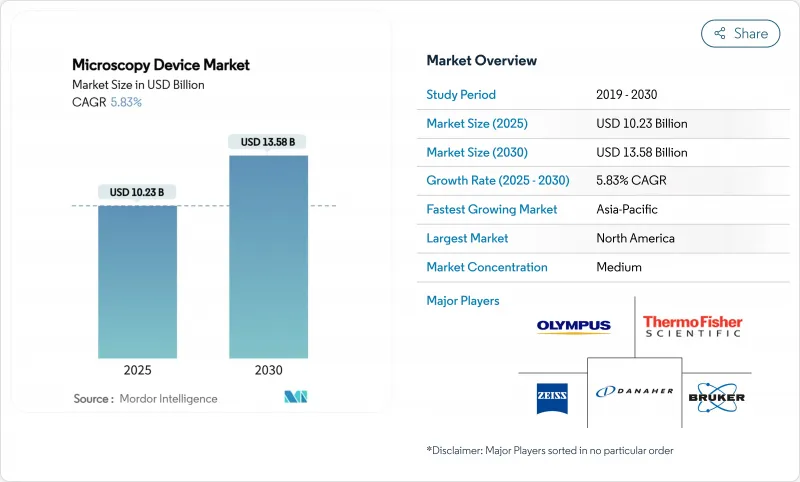
|
市場調査レポート
商品コード
1851471
顕微鏡装置:市場シェア分析、産業動向、統計、成長予測(2025年~2030年)Microscopy Device - Market Share Analysis, Industry Trends & Statistics, Growth Forecasts (2025 - 2030) |
||||||
カスタマイズ可能
適宜更新あり
|
|||||||
| 顕微鏡装置:市場シェア分析、産業動向、統計、成長予測(2025年~2030年) |
|
出版日: 2025年07月15日
発行: Mordor Intelligence
ページ情報: 英文 115 Pages
納期: 2~3営業日
|
概要
顕微鏡装置の市場規模は2025年に102億3,000万米ドルに達し、CAGR 5.83%を反映して2030年には135億8,000万米ドルに拡大すると予測されています。

政府のナノテクノロジー資金援助、半導体の微細化目標、AIを活用した診断ワークフローが共同で需要を再形成し、顕微鏡を画像キャプチャツールから予測分析エンジンへと昇華させる。低温電子顕微鏡、量子センシング、卓上型超解像プラットフォームは、ゲルマニウムの供給制約と熟練労働者不足がユーザーを自動化へと向かわせる中、牽引役となっています。大手ベンダーは、人工知能、ロボット工学、クラウド解析を次世代装置に組み込むことでこれに対応します。成熟しつつあるデジタル病理学、サブ5ナノメートルチップ製造、量子材料研究は、2030年までの顕微鏡装置市場の1桁台半ばの成長を支える幅広い機会セットとなっています。
世界の顕微鏡装置市場の動向と洞察
顕微鏡技術の進歩
ミュンヘン工科大学の量子センシング顕微鏡は、核スピンシグナルを光学データに変換することで、10ナノメートルのスケールで細胞の詳細を捉え、光損傷を排除し、新たな解像度のベンチマークを設定しました。浙江大学の構造化照明中赤外光熱顕微鏡は、60ナノメートルの化学画像を提供し、従来の性能を倍増させ、高分子科学に不可欠な分子特異性を追加しました。エンタングルフォトンを用いた補償光学は、さらに組織の歪みを除去し、従来のガイドスター法では達成できなかった鮮明な生体内画像を生成します。これらの進歩は、顕微鏡装置市場全体のプレミアム需要を促進し、サプライヤーによる機能統合を促し、ユーザーの探索サイクルを短縮します。
拡大するナノテクノロジーとライフサイエンス研究開発資金
米国国家ナノテクノロジーイニシアティブは、2025年に向けて22億米ドルの記録的な割り当てを確保し、合成とリアルタイムの顕微鏡検査を組み合わせた材料イノベーションプラットフォームに資金を回しました。NSFは8,400万米ドルを全米ナノテクノロジー協調基盤に追加し、16カ所で高度な特性評価への共有アクセスを拡大した。NIHのハイエンド機器プログラムでは、免疫療法や画像診断のための機器プールを拡大するため、顕微鏡スイートに最高200万米ドルが授与されるようになりました。民間企業は通常、これらの助成金と並行して共同投資を行っており、顕微鏡装置市場への影響を拡大し、将来のブレークスルーを後押ししています。
高い資本コストと運用コスト
最先端のCs補正STEMは500万米ドルに達し、年間サービス料は購入価格の30%に達します。防振、温度安定性、電磁シールドのための追加インフラは、多くの提案を数百万米ドルのプロジェクトにしてしまいます。小規模の大学や病院は躊躇しており、顕微鏡装置市場に二層の顧客層を作り出しています。ISO 13485と調和するFDAの新規則が2026年に導入され、より広範な品質文書化が義務付けられるため、機器メーカーのコンプライアンスコストが上昇します。
セグメント分析
電子顕微鏡は2030年まで6.67%のCAGRで推移する一方、光学顕微鏡は2024年に42.23%の収益基盤を維持し、ライフサイエンスや材料ラボのルーチンワークフローを支えます。収差補正された透過電子顕微鏡は現在、半導体工場や製薬研究者がミッションクリティカルと考えるサブオングストロームの鮮明度に到達しています。極低温電子顕微鏡は、タンパク質の結晶化を回避し、抗ウイルスおよび腫瘍学プログラムを迅速に進める受容体部位を表面化する、プレミアムニッチを占めています。日立のSU3900SEは、300mmウエハーと5kgサンプルに対応し、研究現場に半導体グレードのスループットをもたらします。
需要パターンは、置き換えよりもむしろ収束を強調しています。超解像光学システムは機械学習と組み合わせて解像度のギャップを埋め、走査型プローブ顕微鏡は量子センサーを活用して非接触原子マッピングを実現します。統合されたAIパイプラインは分析時間を短縮し、参入障壁を下げ、顕微鏡装置市場は着実な機能拡張の道を歩んでいます。
地域分析
北米は2024年に39.89%の売上高を占め、22億米ドルの国家ナノテクノロジーイニシアティブの高揚とNIHハイエンド機器助成金によって推進されました。同地域には、学術界と産業界が組んだ量子電子顕微鏡コンソーシアムがあり、顕微鏡デバイス市場の主導的地位を固めています。しかし、中国からのゲルマニウムとガリウムの輸出抑制により、レンズグレードのゲルマニウムは75%も高騰し、リードタイムは40週間に延び、サプライチェーンの脆弱性が露呈しました。
2030年までのCAGRはアジア太平洋地域が最速の6.89%を記録します。日本はチップツールの売上を3倍にするという野望を抱いており、中国はオプティクスのローカライゼーションを推進し、韓国は鋳造を拡大しています。MA-tekは、Rapidus Corpの500万米ドルCs補正TEM受注により、2025年に日本の売上が倍増すると見ています。地政学的な軋轢はライセンス供与の不確実性をもたらすが、企業はジョイントベンチャーや技術共有のセーフガードを通じてこれを回避しています。
欧州は、製薬研究、精密工学の伝統、イメージングイノベーションをインキュベートするEMBLとの提携により、バランスの取れた成長に寄与しています。ISO13485の調和ルールは国境を越えた機器認可を簡素化し、連邦政府のプログラムは研究所のアップグレードを助成します。しかし、空間生物学や量子材料といった付加価値の高いニッチ分野では、顕微鏡市場の勢いは衰えていないです。
その他の特典:
- エクセル形式の市場予測(ME)シート
- 3ヶ月間のアナリストサポート
よくあるご質問
目次
第1章 イントロダクション
- 調査の前提条件と市場の定義
- 調査範囲
第2章 調査手法
第3章 エグゼクティブサマリー
第4章 市場情勢
- 市場概要
- 市場促進要因
- 顕微鏡の技術的進歩
- ナノテクノロジーとライフサイエンスの研究開発資金の増加
- 半導体デバイスの小型化
- AI対応自動デジタル病理ワークフロー
- 構造に基づく創薬のためのクライオ電子顕微鏡の急速な普及
- インラインQC用卓上型超解像システム
- 市場抑制要因
- 高い資本コストと営業コスト
- 熟練顕微鏡技師の不足
- 産学技術移転における知財訴訟リスク
- 精密光学部品のサプライチェーンのボトルネック
- バリュー/サプライチェーン分析
- 規制情勢
- テクノロジーの展望
- ポーターのファイブフォース分析
- 新規参入業者の脅威
- 買い手の交渉力
- 供給企業の交渉力
- 代替品の脅威
- 競争企業間の敵対関係
第5章 市場規模と成長予測
- 顕微鏡タイプ別
- 電子顕微鏡
- 透過型電子顕微鏡(TEM)
- 走査型電子顕微鏡(SEM)
- 極低温電子顕微鏡(Cryo-EM)
- 光学顕微鏡
- 明視野&位相差
- 蛍光&コンフォーカル
- その他
- 走査型プローブ顕微鏡
- その他のテクノロジー
- 電子顕微鏡
- 用途別
- ナノテクノロジー調査
- ライフサイエンス
- 半導体・エレクトロニクス
- 材料科学・冶金学
- その他
- エンドユーザー別
- 病院、クリニック、診断ラボ
- 学術研究機関
- 製薬・バイオテクノロジー企業
- 半導体・エレクトロニクスメーカー
- その他
- 地域別
- 北米
- 米国
- カナダ
- メキシコ
- 欧州
- ドイツ
- 英国
- フランス
- イタリア
- スペイン
- その他欧州地域
- アジア太平洋地域
- 中国
- 日本
- インド
- オーストラリア
- 韓国
- その他アジア太平洋地域
- 中東・アフリカ
- GCC
- 南アフリカ
- その他中東・アフリカ地域
- 南米
- ブラジル
- アルゼンチン
- その他南米
- 北米
第6章 競合情勢
- 市場集中度
- 市場シェア分析
- 企業プロファイル
- Thermo Fisher Scientific(FEI)
- Carl Zeiss AG
- Danaher Corp.(Leica Microsystems)
- Hitachi High-Tech Corp.
- JEOL Ltd.
- Nikon Corp.
- Olympus Corp.
- Bruker Corp.
- Park Systems Corp.
- Tescan Orsay Holding
- Labomed Inc.
- Andor Technology Ltd.
- Oxford Instruments PLC
- Becton Dickinson & Co.
- Asylum Research
- NT-MDT Spectrum Instruments
- Ametek(Cameca)
- ASML Holding(Nikon Metrology)
- Keyence Corp.
- Cytovale Inc.

